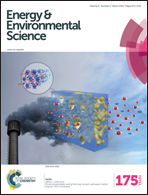High-performance polymer solar cells based on a 2D-conjugated polymer with an alkylthio side-chain†
Abstract
Two new two-dimension (2D)-conjugated copolymers (PBDTT-S-TT-CF and PBDTT-O-TT-CF) were designed and synthesized for the application as donor materials in polymer solar cells (PSCs) and for further investigation of the effect of alkylthio side chains on the photovoltaic performance of 2D-conjugated polymers. The two copolymers were prepared by the copolymerization of alkylthio- or alkoxy-thienyl-benzodithiophene (BDTT-S or BDTT-O) and thienothiophene with carbonyl and fluorine substituents (TT-CF), and they demonstrated strong and broad absorption spectra in the wavelength region from 450 nm to ca. 800 nm. The HOMO energy level of PBDTT-S-TT-CF was further down-shifted to −5.44 eV by alkylthio substitution on thiophene conjugated side chain of BDT unit and the carbonyl and fluorine substitution on TT unit. The inverted-structured PSCs based on PBDTT-S-TT-CF:PC70BM exhibited a high PCE of 9.58% with a remarkably high Voc of 0.89 V and a high FF of 71.0%. The PCE of the PSCs based on PBDTT-O-TT-CF also reached a high value of 8.68% with a Voc = 0.78 V and a higher Jsc = 16.5 mA cm−2, which is benefited from the broad absorption of PBDTT-O-TT-CF. The results further confirm the unique advantages of the alkylthio side chain in the design of state-of-the-art polymer donor materials for high performance PSCs with high Voc.


 Please wait while we load your content...
Please wait while we load your content...